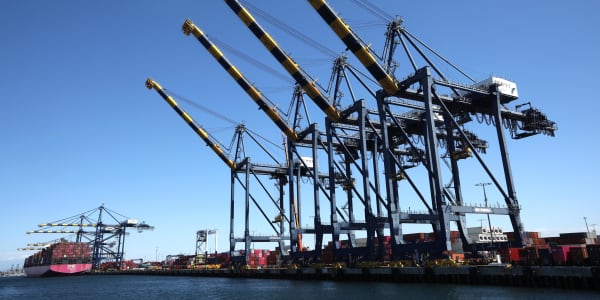The road freight industry has a big problem.
Every day, thousands of trucks drive along miles of freeways and highways completely empty — and the distances they drive with zero cargo onboard reaches many billions of miles every year.
After a truck delivers its load, it may not have any goods to carry for the return leg of its journey and drives back empty.
"I don't think it is widely known," said industry veteran Martin Willmor, when asked if the public is aware of the problem in a phone call with CNBC. "There's all sorts of barriers [to solving it]. If it was ... easy, it would have been done years ago," he added.
The problem of empty trucks has gotten worse in Europe, with the proportion of mileage driven by vehicles with zero cargo going up.
In the EU, trucks clocked up so-called "deadhead" distances of around 34 billion kilometers (21 billion miles) in 2021, according to European Commission data. This equates to more than a fifth (21.2%) of the total distance traveled by road freight in the bloc last year, up from 20% in 2020.
A complicated business
By its nature, the road freight industry is complex: manufacturers or retailers that need to transport goods are in myriad locations, shipping varying amounts of cargo to many destinations, sometimes relying on multiple carriers to do so.
Trucking companies ideally need one customer (or customers) for the outward journey and another for the return. If they don't have two customers, vehicles run empty. But, as well as needing a shipment for the return journey, they also need a truck that matches their load, with equipment such as refrigeration or a vehicle with a fork-lift attached.
"There are a lot of factors involved in finding the next compatible load," J.P. Wiggins, co-founder of transportation management software firm 3GTMS, told CNBC via email.
"Is the equipment compatible, does the driver need to get home, is the driver due for a mandatory sleep break?" he added.
Digital transport
A reliance on analog processes can also be an issue, explained Willmor, who is co-founder and CEO of U.K.-based DigiHaul, a platform that matches shipments with carriers and aims to tackle the empty trucks problem.
"The supply chain [sector] is one of the last industries to go digital," he told CNBC in a phone call. "There's a lot of talk from a warehousing point of view, whether it's robotics [or] automated goods vehicles, but actually, from a transportation point of view, we've lacked a digital solution," he said.
Willmor, who launched DigiHaul after a long career at DHL, said some hauliers still book deliveries via phone or email. This means information about what is being sent where isn't always centrally held, making it harder to find shipments to fill trucks for the return leg.
He added that one U.K. retailer DigiHaul worked with calculated it had trucks travel empty for around 650,000 km over a six-week period in November and December 2021, a costly endeavor.
We need to change. As an industry, we've got an obligation to do something differentMartin WillmorCo-founder and CEO, DigiHaul
"We've seen fuel prices go through the roof ... everything's impacting the cost to serve for our customers. And the essence of our business ... is removing waste from the supply chain," Willmor said.
The price of sending goods via road freight in Europe reached an "all-time high" according to an index published by the International Road Transport Union in a report last month. Rates for European contract freight rose 6.1 points in the second quarter of the year, when compared to the first quarter, with rates going up 13.1 points year-over-year.
Along with saving money, shippers also want to reduce their environmental impact, with one DigiHaul retail client aiming to take 100,000 trucks off the road by 2026. One way of doing that is to be more flexible on collection times by plus or minus 24 hours, which increases the chance of being paired with a returning truck, Willmor said.
But there also needs to be fundamental change, he added. "We still see a kind of disconnect, where you've got business leaders that are really focused around sustainability ... But then you get local operators, or, you know, transport offices that are doing something quite different," he said.
"We need to change. As an industry, we've got an obligation to do something different," Willmor added.
U.S. reduces empty miles
In the U.S., meanwhile, the distances driven by empty trucks decreased from 20.6% in 2020 to 14.8% in 2021, according to the American Transportation Research Institute. "Under the pressure of rising fuel prices, carriers achieved some of the lowest deadhead mileage in years," it stated in an August report.
But running trucks without loads is still a problem, especially since costs are going up: U.S domestic freight rates increased 28% in the year to July (across all modes of transport including road and air), reaching a potential peak.
"Empty miles mean less revenue for carriers. It means increased costs because an empty truck on the road still consumes fuel, still needs a driver, and still requires regular maintenance," according to Robb Porter, an executive at Loadsmart, a freight technology company, in an email to CNBC.
"If the carrier isn't making money, it means the carrier is losing money — and a lot of it," he added.
Supply chain transparency
It's a problem that Loadsmart is also trying to tackle. A year ago, it launched a platform called Flatbed Messenger to match empty trucks with shippers needing to transport goods, in a partnership with The Home Depot. This means the retailer can share spare capacity in its trucks with others.
"Fleets that are dedicated to one customer are often plagued with many empty miles. Flatbed Messenger feeds the truck's location, its price, and its destination into algorithms that match the information to a shipment, which benefits both shippers and carriers," Loadsmart said in an online release.
In the year to August 30, the platform has meant 1.9 million fewer miles have been driven by empty trucks, Porter at Loadsmart told CNBC by email. Loadsmart raised $200 million in a funding round led by SoftBank in February, valuing the company at $1.3 billion.
"Our hope for [the] future is that we — and others in our industry — are able to not only reduce empty miles, but to chip away at the distrust between parties, create visibility into supply and demand, and develop a transparency that can address deep-rooted supply chain inefficiencies," Porter said.
But, that requires a certain amount of data sharing by competitors, according to Wiggins at 3GTMS. "We may need government help as getting competitors to collaborate is often like herding cats," he said.
- CNBC's Frank Holland contributed to this report.




